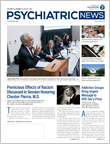Borders and oceans may divide nations, but they can serve as bridges to cooperation and learning for psychiatrists.
As one part of a broader outreach to psychiatric societies around the world, leaders of APA and the Japanese Society of Psychiatry and Neurology (JSPN) have been steadily expanding their contacts in recent years.
Then APA President Maria A. Oquendo, M.D., Ph.D., and CEO and Medical Director Saul Levin, M.D., M.P.A., traveled to JSPN’s 2016 Annual Meeting. During the recent APA Annual Meeting in San Diego and in follow-up discussions, the leaders of the two organizations have discussed ways to increase cooperation in areas ranging from research to policy.
“The seeds of outreach we are planting with other international psychiatric organizations are vital and have begun to bear fruit,” said APA President Anita Everett, M.D. “They are yielding benefits by allowing APA and its international partners to share important information on psychiatric education, training, best practices in such areas as delivery of services to underserved populations, and research.”
The stepped-up collaboration and exchange around the Pacific Rim includes not only the United States and Japan, but other countries too. In San Diego, presenters in one symposium discussed models of collaborative care in the United States, Japan, Australia, New Zealand, Korea, Hong Kong, and Taiwan. Tsuyoshi Akiyama, M.D., Ph.D., a clinical professor of psychiatry at Tokyo University and director of neuropsychiatry and psychosomatic medicine at NTT Medical Center Tokyo, helped coordinate the session. Akiyama, who speaks English fluently, is an APA international distinguished fellow and a board member of the JSPN.
The connection drew even closer this year in San Diego when for the first time young Japanese psychiatrists participated in APA’s Research Colloquium for early career psychiatrists. Previously, this mentorship program was open only to candidates from the United States, but participation was expanded to allow overseas societies to nominate and fund representatives. For its part, the JSPN also has a fellowship available for APA members to present at the JSPN annual meeting.
A month after the APA meeting, another APA delegation visited Japan. That group included Kenneth Kendler, M.D., the Rachel Brown Banks Distinguished Professor of Psychiatry and director of the Psychiatric Genetics Research Program at Virginia Commonwealth University; Robert Freedman, M.D., editor of the American Journal of Psychiatry and a professor at the University of Colorado; Michael First, M.D., editorial and coding consultant for DSM-5 and the chief technical and editorial consultant on the ICD-11 revision project; former APA President Michelle Riba, M.D., a professor of psychiatry at the University of Michigan and secretary for scientific publications at the World Psychiatric Association; and Philip Wang, M.D., director of APA’s Division of Research.
One area of mutual interest arose from the World Health Organization’s (WHO) proposal to move dementia from the mental and behavioral chapter in the ICD-11 beta version to the neurological chapter, a shift that would have threatened reimbursements to psychiatrists treating older populations, said Wang. Coordinated letters of protest to WHO from the two societies helped to keep dementia disorders in the mental and behavioral chapters. “JSPN has been an ally in ensuring that the ICD-11 beta version treats dementia diagnoses appropriately,” said Wang.
The two societies also discussed possible international memberships for JSPN members to allow them to gain access to APA’s online educational and scientific publications.
One difference between the two groups is that until recently, the JSPN has served as both a medical society and the profession’s credentialing organization. It is now moving to separate those two functions, as is the case in the United States, said Riba in an interview. “We discussed that process and talked about inviting Japanese counterparts to come to the U.S. to meet with training directors and work on documentation.”
That exchange of expertise is a two-way street, Riba emphasized. “We also explored what the JSPN can teach us about amphetamine use, based on research in Japan.” ■
